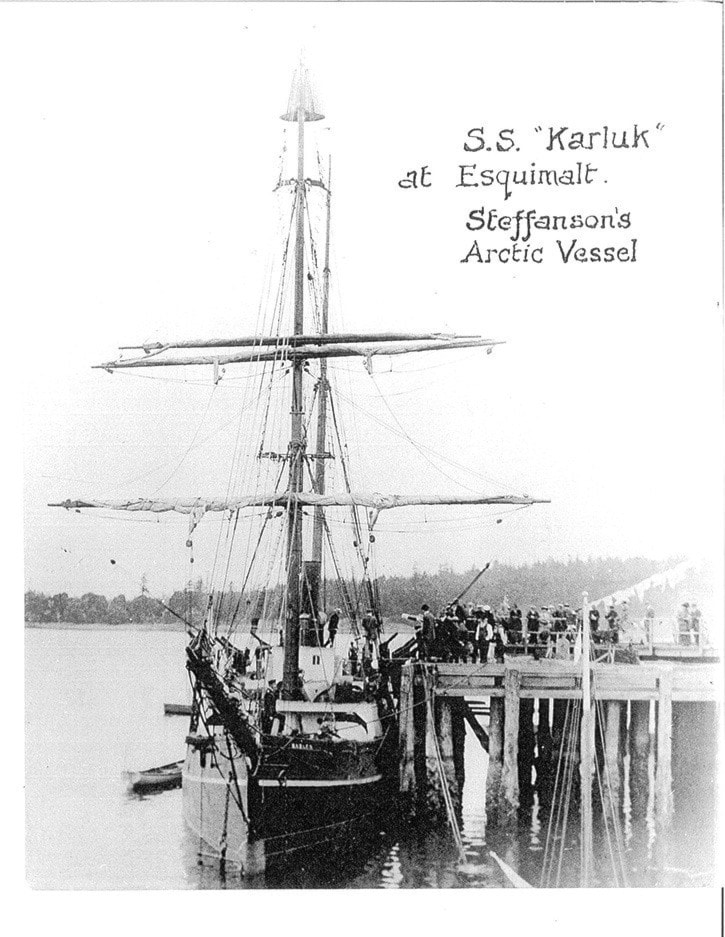With the last few months of interest in the story of the Franklin Expedition, my thoughts turned to another ill-fated Arctic expedition, which has a direct connection not only with Victoria, but with the Maritime Museum of B.C.
In our collection we have a few bits and pieces, including an oar, from a former whaling vessel called the Karluk.
In 1913 this already worn ship embarked upon a doomed journey that would captivate the Canadian public for more than a year.
The Karluk had begun life in 1884 as a California-built brigantine designed for fishing, but was converted into a whaler a decade later. Her bows and sides were covered with two-inch ironwood sheathing in this conversion, and she completed 14 successful whaling trips.
She was not a large vessel, nor particularly suited for extreme conditions. Only 321 gross tons, and 39 metres in length, Karluk was powered by sail and a coal-fed steam engine of only 150 horsepower.
When she was purchased by a strangely charismatic explorer called Vilhjalmur Stefansson in 1913 for $10,000 there was immediate rumor that she was unfit for the job she had been assigned, for Stefansson intended to take this 30-year old vessel on a perilous journey into the most inhospitable of Canadian environments: the Arctic.
Stefansson was hired by the Canadian government to lead the Canadian Arctic Expedition, whose purpose was to explore Western Arctic regions for ethnological, geological, zoological and botanical study. He intended to set up a research station on Herschel Island to advance Canada’s knowledge of, and sovereignty over, the Arctic.
He led a team of 31 people, including an Inuit family with two children aged 3 and 8, sailors, explorers and scientists aboard the Karluk, which was bound for Nome, Alaska, there to head west and rendezvous with two other ships at Herschel Island.
Karluk left Esquimalt harbour in June 1913, under the command of Capt. Robert Bartlett, who had Arctic experience as an explorer and seal hunter. He was later credited with saving the lives of most of the people who survived this ill-fated voyage.
Right from the beginning Bartlett harboured doubts about the Karluk’s suitability for her task. She was not sturdy enough in the bow to break ice, nor was her engine strong enough to push her through packed ice which would inevitably form when the weather cooled. He assumed that Stefansson, who was famed as an experienced Arctic explorer, did not intend the ship to spend the winter in Arctic waters.
To compound his concerns, Stefansson had packed inferior quality cold-weather clothing, much of it second-hand, and cut-grade pemmican to save on costs.
As fate would have it, that August, shortly after leaving Nome, Karluk was caught in early pack ice, which trapped the vessel and her crew and began to sweep them west. Unable to rendezvous with the other ships at Herschel Island, the crew simply had to wait.
When the current slowed for a few days in September, Stefansson took a few hunters and set off across the ice on a supposed hunting trip. The ice once again began to sweep the Karluk west, and Stefansson’s party never found her again.
There has been a good deal of speculation that Stefansson’s decision to go hunting in such circumstances was really a decision to abandon the ship and its crew, knowing that the Karluk simply wasn’t a match for the cruel Arctic winter which was closing in on them. He and his party safely returned to Alaska.
The ship, meanwhile, drifted helplessly for months. Finally, in January 1914, the ice floes finally punctured the hull and she sank as the crew, evacuated onto the pack ice along with as many of their supplies as they could save, watched.
Marooned, the crew splintered into factions. Two groups of four set off on their own, and perished from cold and hunger, their remains not found for years. The remaining 17 made it to Wrangel Island where they set up camp. Cold, suffering from malnutrition and low morale, most were unable to forge ahead towards the mainland.
Bartlett and Katatkovik, one of the Inuit guides, set off on foot towards Siberia and then to the Bering Strait to summon help. When he finally reached Alaska, it was the first news that Canadians had had about the fate of the Canadian Arctic Expedition in eight months.
By the time he returned to Wrangel Island with two rescue ships it was September 1914. Three more of his crew had perished in the meantime: one from a mysterious gunshot wound, and two from of malnutrition (specifically nephritis) as a result of poor-quality pemmican.
This remarkable story of tragedy and endurance has come down to us from the survivors and despite its direct connection with Victoria, remains to this day far less well-known that that of the Franklin Expedition.
•••
Kate Humble is an historian and the education curator for the Maritime Museum of B.C. Questions can be sent to: khumble@mmbc.bc.ca.
